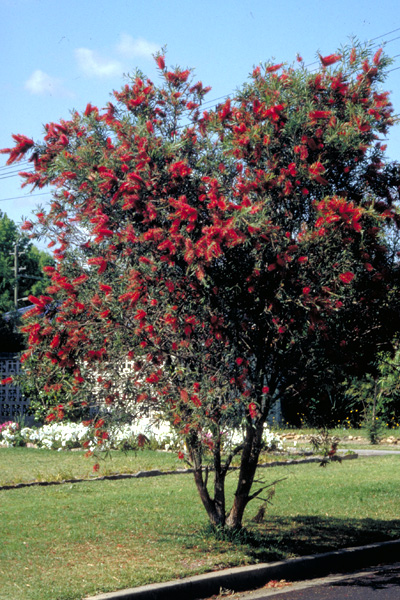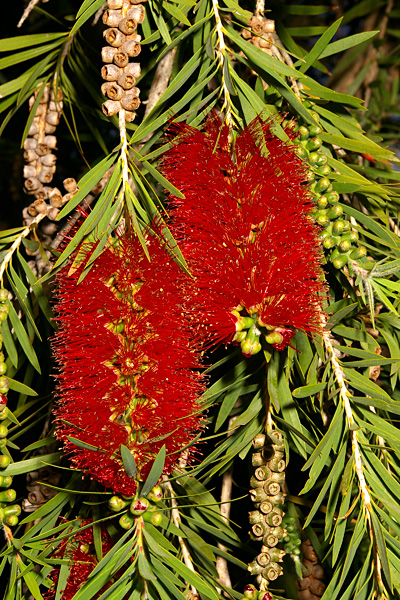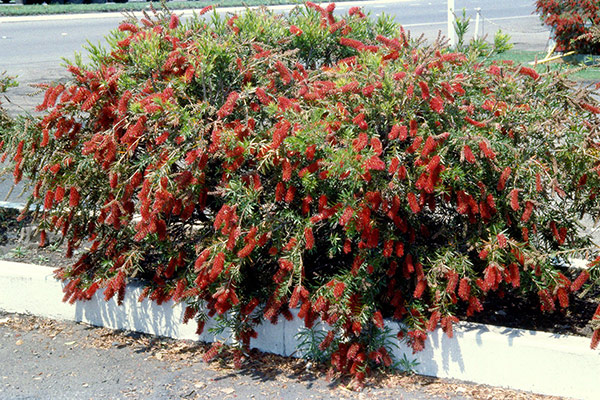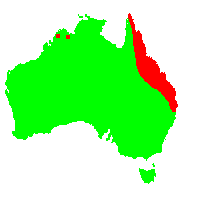General Description:
There is ongoing controversy about whether Melaleuca or Callistemon should be used for the bottlebrush species – see footnote box. Some herbaria have now adopted the name Melaleuca viminalis for this species, however, this reclassification has not been adopted in the Australian Plant Census (which is accepted by ANPSA as the authority on Australian Plant nomenclature).
Callistemon viminalis is probably one of the best known and most widely cultivated of all bottlebrushes – only C.citrinus would challenge that status. The species and its cultivars are widely planted in Australia and overseas. Until recently, its natural distribution was considered to be restricted to eastern Australia but recent discoveries in the Kimberley region of Western Australia have extended its range (see Nuytsia 20: 27-36(2010), “Melaleuca (Myrtaceae) of Western Australia: five new species, three new combinations, one new name and a new state record“.
The weeping bottlebrush is typically a small tree with pendulous foliage although some forms are more pendulous than others. It reaches a height of about 10 metres in its natural habitat but is usually smaller in cultivation, particularly in temperate areas where it is an attractive and reliable small tree for street planting. There is also a compact form, known as ‘Captain Cook’ – see below.
The brushes are usually about 70 mm long by 50 mm diameter, bright red in colour and are usually seen in spring and sometimes in autumn. The seed capsules that follow the flowers release the seed annually, unlike most other Callistemon species, where the seed remains in the capsules for many years.
In the wild, C.viminalis is usually found along watercourses and it performs best in cultivation if a reliable water supply is available. Once established, however, it is able to tolerate extended dry periods. The plant performs best in medium to heavy soils and can tolerate less than perfect drainage but may be damaged by moderate to heavy frost. It responds to annual fertilising after flowering. Although the plant will respond to pruning, this can have the effect of destroying the appearance of weeping forms. In common with other bottlebrushes, plants flower best in a sunny location but they will tolerate considerable shade at the expense of flowering performance.
There are a number of widely grown cultivars of C.viminalis. One of the most popular in cultivation is Callistemon ‘Captain Cook’. This cultivar was widely promoted to commemorate the 200th anniversary of Captain James Cook’s discovery of the east coast of Australian in 1770 and it remains popular today. C.”Captain Cook” is a dense, bushy shrub 1.5 to 2 m tall by a similar spread. It has narrow leaves 50-60 mm long and produces masses of red brushes in mid to late spring (October to November). Flowers may also appear in late summer and autumn.
Like most Callistemon cultivars, C.”Captain Cook” produces viable seed which germinates easily. However, because of seedling variation, any plants produced from this seed will not be identical to the parent plant. Unfortunately C.”Captain Cook” suffered from this problem in the 1970s with the result that some plants did not retain the dwarf habit which is its main horticultural characteristic. This problem does not seem to affect plants purchased today from reliable sources. Plants produced from cuttings (which usually strike readily) will produce genetically identical plants to the parent.
Other popular cultivars of Callistemon viminalis include:
- Dawson River Weeper – spreading small tree to 5 metres; bright red brushes, yellow tipped
- Hannah Ray – small, weeping tree to about 4 metres high; bright red brushes
- “Rose Opal” – medium shrub to about 2 metres; red brushes, turning rose-coloured
Propagation of C.viminalis is easy from both seed and cuttings. As with C.’Captain Cook’, all of the other named cultivars must be propagated from cuttings due to genetic variation that occurs in seedlings.
Craven’s re-classification has been adopted in a 2013 publication “Melaleucas: their botany, essential oils and uses” by Joseph J. Brophy, Lyndley A. Craven and John C. Doran.

Callistemon viminalis
Photo: Brian Walters

Callistemon viminalis
Photo: Brian Walters

Callistemon ‘Captain Cook’
Photo: Brian Walters
Other Native Plant Profiles
 Australian Native Plants Society (Australia)
Australian Native Plants Society (Australia)